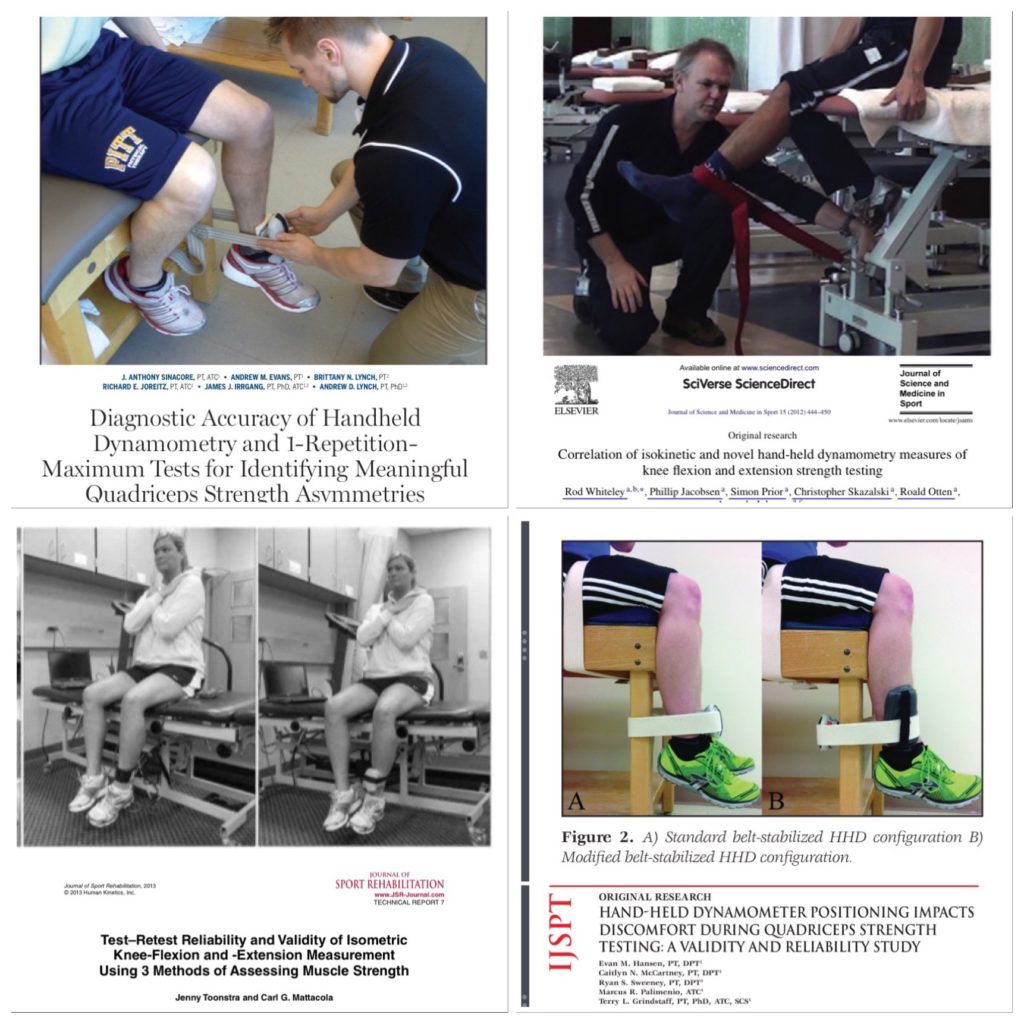“Hey Scot, I read Erik Meira’s blog post/talked to Terry Grindstaff/saw a tweet from Matt Ithurburn/woke up angry and now realize that testing quad strength is something I actually DO want to do. I now tell everyone that “there is guessin’ & then there is assesin’” and I want some certainty in my life. So how do I test the quad? And what am I testing anyway?”
Good questions! This post will attempt to put together some answers, or at least some directions to move towards the answers.
Caveat: quad tests are “functional” and the reason why is embedded in motor control, dynamical systems and other areas that are fun to discuss but not the topic here. An in depth discussion will be done later – till then see this post by Erik. This article is “living” and will continue to be updated based on feedback and time.
When testing the “quad” we are actually looking at the knee extension torque that the individual can generate. The quad is the prime mover here but this number will be moderated by many other factors like tolerance, inhibition, familiarity with the test, level of motivation, cuing, and etc. Torque is the product of the length of the lever and the force acting on it. It is measured in newton meters (or foot pounds). In the knee it is coming from the patellar tendon pulling the knee into extension via its attachment on the tibia. However, when it is measured the distance of the dynamometer from the knee must be taken into account. Since torque is the product of two factors BOTH must be accounted for. For the sake of testing, if setup (lever arm and angle of blocking force), are maintained the same then the force alone can be reported. In general it is a good practice to calculate torque since most goals are established based on newton meters per kilogram of subjects weight. (>3.0 Nm/kg for knee extension.)
Rate of force development (RFD) is also important. This is a measure of how fast force increases per unit of time. A high RFD with a low peak force is a good way to fail faster. If forces are not at a level sufficient to overcome external resistance then getting to that insufficient level faster obviously isn’t going to add much. On the same note, sufficient forces that cannot be generated in time are also of little practical use. Because of this, measurement of peak torque at the knee is always step one of the assessment.
It is imperative that a sufficiently sensitive device is used to record the forces generated. This is one of the reasons why something like manual muscle testing offers no value for clearing someone to return to play or identifying anything other than massive asymmetries. A sensitive device used incorrectly provides the practitioner with more confidence in their number but doesn’t actually improve the test. This is especially important when testing something like knee extension where forces are relatively high. Therefor fixation that exceeds force generation must be utilized during these tests.
How to test:
Step 1: Place subject in a seated position on a chair or plinth that is firm (compression in the structure or padding will introduce [ more] movement into a [somewhat] rigid system). If possible a backrest and straps to hold the subject still should be used. If they are not available some research supports the idea that testing is still valid but there will be less reliability.
Step 2: Fixate the lower leg. This should occur at the distal tibea in a reproducible and comfortable location (usually just proximal to the talocrural joint). The fixation should be at right angles to the lower leg. The knee can be tested in 60 deg of extension (most commonly used and usually highest forces due to length-tension relationship) or 90 deg (clinically the easiest to set up when using a plinth)

Step 3: The patient is allowed 3-5 warmup tests with 15-90 seconds of rest between each rep. Effort progresses from 50% to 95/100%. A complete rest is then allowed 60+ seconds, and the test is performed. This is typically 2-5 max effort tests again separated with complete rest.
- If looking for max force only a cue “kick as hard as possibly ramping up over 1 second to a max that is held” can be used. The test usually lasts 3-5 seconds.
- If looking for RFD then the subject is cued “kick as hard and fast as possible” and the test can last 0.5-3 seconds.
- If looking for both then cue “Kick as fast and hard as possible” an dthe test should be long enough to allow peak force generation (2-3+ seconds)
Step 4: The best test of the series is taken and used (you can also average but the majority of research has used best effort). Torque is calculated by measuring the distance from the center of the knee to the fixation of the dynamometer is taken and the force is multiplied by the distance to get the torque.
Selected references: 1
1. Maffiuletti NA, Aagaard P, Blazevich AJ, Folland J, Tillin N, Duchateau J. Rate of force development: physiological and methodological considerations. Eur J Appl Physiol. 2016;116(6):1–26.
2. Sinacore JA, Evans AM, Lynch BN, Joreitz RE, Irrgang JJ, Lynch AD. Diagnostic Accuracy of Handheld Dynamometry and 1-Repetition-Maximum Tests for Identifying Meaningful Quadriceps Strength Asymmetries. J Orthop Sports Phys Ther. 2017;47(2):97–107.
3. Mentiplay BF, Perraton LG, Bower KJ, et al. Assessment of Lower Limb Muscle Strength and Power Using Hand-Held and Fixed Dynamometry: A Reliability and Validity Study. Haddad JM, ed. PLoS ONE. 2015;10(10):e0140822–18.
4. Bohannon RW, Kindig J, Sabo G, Duni AE, Cram P. Isometric knee extension force measured using a handheld dynamometer with and without belt-stabilization. Physiother Theory Pract. 2012;28(7):562–568.
5. Toonstra J, Mattacola CG. Test-retest reliability and validity of isometric knee-flexion and -extension measurement using 3 methods of assessing muscle strength. J Sport Rehabil. 2013 Feb 18;22(1). pii: 10.1123/jsr.2013.TR7. doi: 10.1123/jsr.2013.TR7.
6. Pietrosimone B, Lepley AS, Harkey MS, Luc-Harkey BA, Blackburn JT, Gribble PA, Spang JT, Sohn DH. Quadriceps Strength Predicts Self-reported Function Post-ACL Reconstruction. Med Sci Sports Exerc. 2016 Sep;48(9):1671-7. doi: 10.1249/MSS.0000000000000946. PubMed PMID: 27054675.
7. Ruschel C, Haupenthal A, Jacomel GF, Fontana Hde B, Santos DP, Scoz RD, Roesler H. Validity and reliability of an instrumented leg-extension machine for measuring isometric muscle strength of the knee extensors. J Sport Rehabil. 2015 May 20;24(2). pii: 2013-0122. doi: 10.1123/jsr.2013-0122. Print 2015 May 1. PubMed PMID: 25310795.
8. Hansen EM, McCartney CN, Sweeney RS, Palimenio MR, Grindstaff TL. Hand-held Dynamometer Positioning Impacts Discomfort During Quadriceps Strength Testing: A Validity and Reliability Study. Int J Sports Phys Ther. 2015 Feb;10(1):62-8. PubMed PMID: 25709864; PubMed Central PMCID: PMC4325289.
